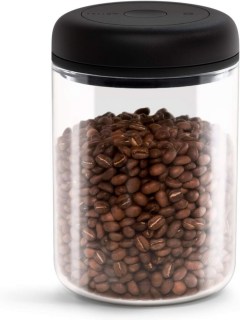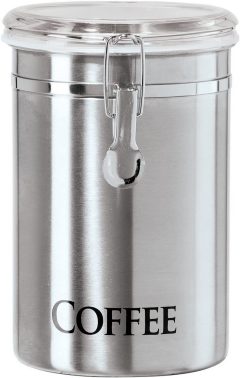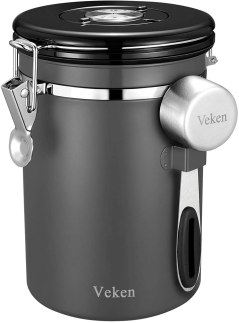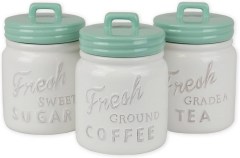Buying guide for best coffee containers
Coffee is at its freshest, boldest, and most delicious when the beans and grinds are stored and brewed under ideal circumstances.
When exposed to oxygen, roasted coffee beans begin to go stale. In fact, when you open a new bag, beans meet oxygen and the clock starts ticking. Thankfully, you can preserve your coffee beans for longer with the proper coffee container.
The right coffee container allows you to store beans and grounds in a place free from oxygen as well as the other culprits that contribute to rapid oxidation: moisture, heat, and light. (Humidity is also a factor, but that can be classified as a combination of moisture and heat.)
If you store your ground coffee in the right container, you have to use the grinder less often. Coffee containers vary in size, price, and preservation effectiveness, so you'll want to consider your needs before selecting the right coffee container for you.
Key considerations
Size
How much coffee do you drink? How many bags do you keep open at any given time? These factors will help determine the container size you need. A pound of coffee beans needs about 16 ounces of volume, which is pretty standard in coffee containers. Generally, you only want to store as much ground coffee as you can drink in a week or two. If you store beans, it’s okay to store a couple of months’ worth in a container. However, as we will see, the quality of the container and its placement will affect bean quality.
Seal
High-quality coffee containers – those that will keep your coffee fresh the longest – generally come with one of two seal types: a vacuum seal or a valve seal.
Vacuum seals are particularly popular; most coffee beans are packaged in vacuum-sealed bags. Vacuum sealing removes the air from within the container so the coffee doesn’t oxidize.
Valve seals are also popular, and many people find them superior to vacuum seals. Coffee naturally emits carbon dioxide, and if you’re trying to preserve beans in a container over a long period of time, you need to remove the excess air the beans create. A valve seal works in one direction, allowing carbon dioxide to escape the canister without inviting oxygen in.
Material
Coffee containers are made of a number of materials including stainless steel, ceramic, plastic, and glass. Stainless steel is highly effective: it’s an airtight material that prevents oxidation, and it can’t be stained by coffee oil. Ceramic is highly effective at keeping beans dry and cool. Plastic is one of the cheapest options, but it’s also the least suited to keep your coffee fresh. It may absorb the coffee oils, ruining the flavor of darker roasts. Furthermore, some varieties of plastic are porous. The last option, glass, may be airtight, but exposing a glass coffee container to sunlight could increase the temperature within, furthering oxidation.
Aesthetic
A coffee container can make an attractive and unique countertop accessory. Remember, however, that a decorative glass container will expose the contents to light and heat, speeding up the oxidation process. A decorative opaque container may be more effective.
Remember, too, that a coffee container should have an airtight seal. A container designed to look “rustic” or “cozy” may lack this feature.
Did you know?
The process by which a molecule loses an electron to oxygen is called oxidation. This causes metal items to rust, food to rot, and coffee to go stale.
STAFF
BestReviews
Features
Bamboo lid
Some coffee containers feature bamboo lids, which are both decorative and effective at sealing off air. A container with a bamboo lid may also have valves or vacuums to preserve coffee. However, it’s worth noting that some containers with bamboo lids are more geared toward aesthetics. These products may not be as good at keeping coffee fresh.
Freshness tracker
Some coffee containers have a simple tracker located on the lid or side that allows you to note the day you put coffee in the container and when it will start to go stale. As mentioned, an effective coffee container will keep beans and grounds fresh for over a week. Noting the date will alert you when the taste may start to fade.
UV protection
Some glass containers are built with UV protection that prevents light and heat from reaching the beans. This is a worthy compromise for those who want a glass container that shows off its contents.
Did you know?
Dark coffee tends to release carbon dioxide and take in oxygen faster than lighter roasts, as it’s oilier and more porous.
STAFF
BestReviews
Accessories
Coffee grinder: Cuisinart Supreme Grind Burr Mill
After beans are acquired, the next step is to grind them. This burr mill will provide a more consistent grind than a blade grinder, resulting in a great-tasting cup of joe.
Coffee maker: Cuisinart 14-Cup Programmable Coffee Maker
Once ground, it’s time to brew. This large programmable machine is ideal for families, and its bold setting will strengthen the pot.
Coffee mugs: Better for You Stainless Steel Mugs
Ready to enjoy your freshly brewed cup? We love this pair of elegant and durable mugs for you and yours to use together.
Coffee container prices
Inexpensive
For under $20, you’ll find an array of plastic or glass coffee containers that will be adequate at keeping coffee fresh. This range may include some smaller stainless steel or ceramic units with valves or vacuums.
Mid-range
Most coffee containers cost between $20 and $30. These tend to be made of stainless steel or ceramic, featuring effective valves or vacuums.
Expensive
For over $30, you’ll find larger coffee containers made of stainless steel and featuring valves to allow air to escape the container. These are often the most effective containers for keeping coffee fresh.
Tips
Wash and dry after use. Coffee will leave residue and flavor behind once the container is empty. Clean it out fully before adding new coffee to avoid cross contamination.
Keep out of the sun. Keep your container away from light, preferably in a cupboard. Heat can increase oxidation, as can moisture.
Avoid the fridge and freezer. While placing your beans in a cool or frozen place may seem like it would preserve freshness, you’re going to lose lots of flavor if you do so. The coffee may not be stale, but it’ll be bland.
Grinding increases surface area. The finer the grind of the coffee, the more exposed it becomes to the elements, and the faster it will oxidize.
Coffee is diverse. There is no set timetable for coffee to go stale. The type of bean, roast, bag, and environment all subtly affect its taste, peak freshness, and lifespan.
FAQ
Q. Where should I place my coffee container?
A. The best location for a coffee container is a cool, dry, and dark place like a cupboard. However, a cupboard may not always be the most convenient place, especially if you want to display a decorative container. If you want to keep your coffee container on display, place it out of direct light and heat — away from windows as well as the oven, stovetop, and dishwasher, all of which emanate heat.
Q. How can I tell if my beans have turned stale?
A. You can use almost all your senses to determine whether your beans have gone bad. Fresh coffee has an oily and relatively glossy surface; beans that look dull may be stale. You can test for the presence of oil by rubbing beans between your fingers.
Smell is another way to check freshness. If the beans lack an aroma, they have likely turned stale. Of course, the last option is to taste. Bland coffee without a potent aroma or flavor has likely passed its expiration date.

























